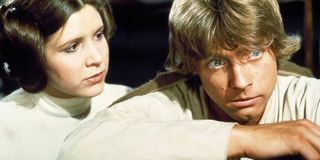Science: The Skywalker Twins Aren't The Same Age Anymore Because Space

As those who have seen Christopher Nolan's Interstellar can attest to, time is a rather complicated bit of subject matter. There are all kinds of factors that play into the concept being relative, and it all becomes even more complex when you introduce science-fiction concepts like lightspeed travel. That's what leads us to this strange bit of Star Wars trivia: as it turns out, Luke Skywalker and Leia Organa may have been born twins, but that doesn't mean that they are the same age.
An article written by students at the University of Leicester has been published in the Journal of Interdisciplinary Science Topics and presents an interesting physics-based analysis explaining why Luke and Leia shouldn't actually be the same age by the time we catch up with them in J.J. Abrams' Star Wars: The Force Awakens - or really past the time they were first separated as children. As the paper explains, Einstein’s theory of relativity states that as an individual moves faster, time around them begins to slow down. This means that as the characters travel at lightspeed over shorter and longer distances, the amount of time around them changes. As you may remember, characters do this quite a bit throughout the Star Wars saga.
While the journal article presents a lot of hard numbers and statistical evidence, Nerdist has presented a simple breakdown using an example from The Empire Strikes Back - specifically the individual trips that Luke and Leia take to go to Cloud City:
If Leia, in the Millennium Falcon, is traveling at 99.999% the speed of light* and Luke is traveling in an X-wing at 99.995% (the small difference matters a lot), then during Leia’s 7-hour trip the galaxy ages 62.6 days, and during Luke’s 7-day trip outside observers age 701 days (nearly 2 years). This means that when the twins first see each other on Lando’s floating palace, Luke is now 638 days younger than his twin. Oh, and that also means Darth Vader was waiting at that dinner table for a long, long time.
Unlike the time that Neill DeGrasse Tyson convinced James Cameron to re-edit Titanic, one can imagine that this bit of real science won't end up reflected in the upcoming Star Wars movies, as the truth is that these incidents of faster and slower travel time should have already been reflected in the Star Wars movies we've seen. That being said, I have zero interest in giving George Lucas any more reasons or ideas to go back and re-edit the original trilogy, so perhaps I'll just leave the point hanging there.
The truth is that Star Wars has never been a series too focused on the application of real science to the science-fiction, but that doesn't necessarily mean that this trivia is absolutely worthless. After all, didn't it just prove to be an interesting way to learn something about physics?
CINEMABLEND NEWSLETTER
Your Daily Blend of Entertainment News

Eric Eisenberg is the Assistant Managing Editor at CinemaBlend. After graduating Boston University and earning a bachelor’s degree in journalism, he took a part-time job as a staff writer for CinemaBlend, and after six months was offered the opportunity to move to Los Angeles and take on a newly created West Coast Editor position. Over a decade later, he's continuing to advance his interests and expertise. In addition to conducting filmmaker interviews and contributing to the news and feature content of the site, Eric also oversees the Movie Reviews section, writes the the weekend box office report (published Sundays), and is the site's resident Stephen King expert. He has two King-related columns.
Most Popular






